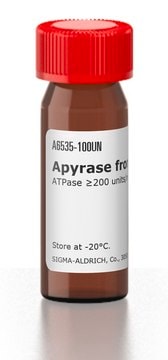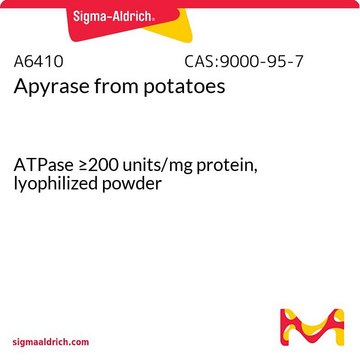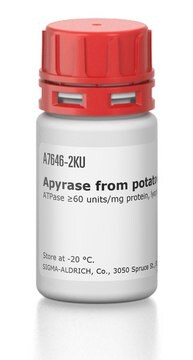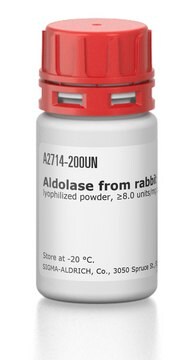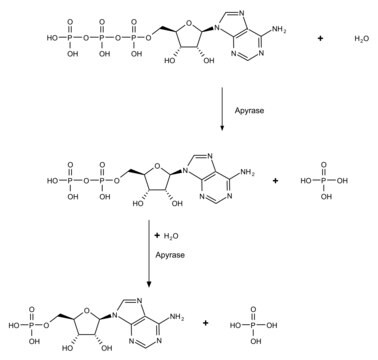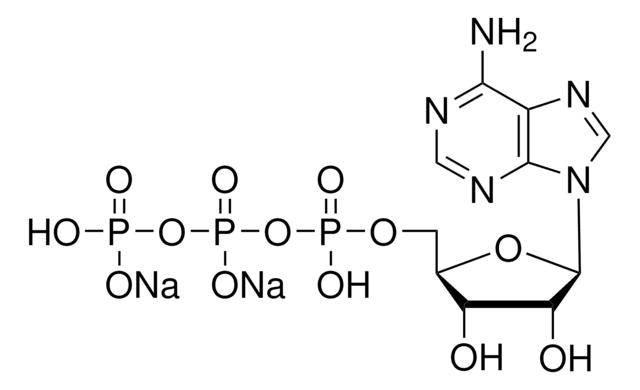A6132
Apirase
ATPase ≥3.0 units/mg protein, lyophilized powder
Sinônimo(s):
Adenosina 5′ difosfatase, Adenosina 5′ trifosfatase
Faça loginpara ver os preços organizacionais e de contrato
About This Item
Produtos recomendados
fonte biológica
potato
Nível de qualidade
tipo
Grade I
Formulário
lyophilized powder
ATPase activity
≥3.0 units/mg protein
composição
Protein, 30-60%
temperatura de armazenamento
−20°C
Procurando produtos similares? Visita Guia de comparação de produtos
Aplicação
Apyrase is used to hydrolyze nucleoside triphosphates and diphosphates. Apyrase, from Sigma, has been used in inhibition studies of platelet-aggregation .
Pelo menos duas isoenzimas são encontradas em diferentes variedades de S. tuberosum: uma com alta proporção de ATPase/ADPase (∼10) e outra com uma baixa proporção (∼1).
Reação: ATP → ADP+Pi → AMP+2Pi.
Reação: ATP → ADP+Pi → AMP+2Pi.
Ações bioquímicas/fisiológicas
Apyrase is found in all eukaryotes and some prokaryotes. Apyrase, from potato, has a crucial role in regulating growth and development. Apyrase is involved in the inactivation of synaptic ATP as a neurotransmitter following nerve stimulation and in the inhibition of ADP induced platelet aggregation to prevent thrombosis . Divalent metal ions are required for activity and best activity is observed with calcium ion at 5 mM.
Embalagem
Sold on the basis of ATPase units.
Outras notas
Mixture of high and low ratio isoenzymes.
Definição da unidade
One unit will liberate 1.0 micromole of inorganic phosphorus per minute at pH 6.5 at 30 °C
forma física
Partially purified, lyophilized powder containing potassium succinate
Palavra indicadora
Danger
Frases de perigo
Declarações de precaução
Classificações de perigo
Resp. Sens. 1
Código de classe de armazenamento
11 - Combustible Solids
Classe de risco de água (WGK)
WGK 1
Ponto de fulgor (°F)
Not applicable
Ponto de fulgor (°C)
Not applicable
Equipamento de proteção individual
Eyeshields, Gloves, type N95 (US)
Escolha uma das versões mais recentes:
Já possui este produto?
Encontre a documentação dos produtos que você adquiriu recentemente na biblioteca de documentos.
Os clientes também visualizaram
Avanish Rai et al.
Bio-protocol, 11(1), e3874-e3874 (2021-03-19)
Isoprenoids represent the largest class of metabolites with amazing diversities in structure and function. They are involved in protecting plants against pathogens or herbivores or involved in attracting pollinators. Isoprenoids are derived from geranyl diphosphate (GPP; C10), farnesyl diphosphate (FPP;
V T Nachmias et al.
FEBS letters, 378(3), 258-262 (1996-01-15)
Capping of the barbed-ends of actin filaments is an important mechanism for control of the cytoskeleton. In platelets, a valuable model system, it has been thought that gelsolin was the major capping protein. We now report that platelets contain approximately
Mathieu F Chevalier et al.
Blood, 121(1), 29-37 (2012-10-09)
Natural regulatory T cells (Tregs) participate in responses to various chronic infections including HIV. HIV infection is associated with a progressive CD4 lymphopenia and defective HIV-specific CD8 responses known to play a key role in the control of viral replication.
Nicholas J Roberts et al.
Plant physiology, 161(1), 556-567 (2012-11-09)
Nodulation in legumes requires the recognition of rhizobially made Nod factors. Genetic studies have revealed that the perception of Nod factors involves LysM domain receptor-like kinases, while biochemical approaches have identified LECTIN NUCLEOTIDE PHOSPHOHYDROLASE (LNP) as a Nod factor-binding protein.
Tsan-Yu Chiu et al.
Plant & cell physiology, 53(11), 1913-1925 (2012-10-05)
Nucleoside triphosphate diphosphohydrolases (NTPDases; apyrases) (EC 3.6.1.5) hydrolyze di- and triphosphate nucleotides, but not monophosphate nucleotides. They are categorized as E-type ATPases, have a broad divalent cation (Mg(2+), Ca(2+)) requirement for activation and are insensitive to inhibitors of F-type, P-type
Nossa equipe de cientistas tem experiência em todas as áreas de pesquisa, incluindo Life Sciences, ciência de materiais, síntese química, cromatografia, química analítica e muitas outras.
Entre em contato com a assistência técnica